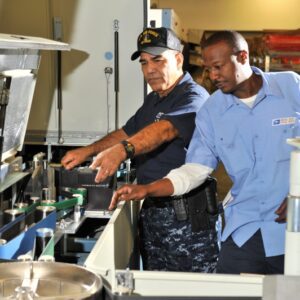November 1, 2015
Management’s New BEM Motto: Run to Failure!
(This article first appeared in the November/December 2015 issue of The American Postal Worker magazine.)
The Postal Service has notified the APWU of management’s intent to move forward with proposed changes to the MS-1 Handbook, which identifies the duties and establishes the staffing for the “building side” of Maintenance Craft work.
In revising the MS-1 Handbook, Operation and Maintenance of Real Property, management is attempting to eliminate a substantial number of Maintenance Craft jobs. In the process, it will make the postal facilities less safe, less comfortable, and less efficient.
The Postal Service intends to replace current procedures with a Building Automation System that remotely monitors building equipment, reduces workhours, eliminates required preventive maintenance, and runs machines to failure.
A March 4, 2014, letter to the APWU reveals how management is attempting to justify the decision:
“One of the most significant technological advances in building systems is ‘intelligent hardware’ that reports equipment condition and operating status to a central monitoring system. This technology is currently used in many USPS building systems and provides the ability to remotely monitor building equipment condition or performance. Conversely, current MS-1 procedures require maintenance employees walk throughout buildings, physically checking the status and performance of numerous pieces of building equipment. This practice is outdated, labor intensive, and an example of how current MS-1 criteria does not reflect present-day technology.” [Sic]
Management is proposing a complex undertaking with significant ramifications. Building Equipment Mechanic (BEM) positions will be most directly affected by the changes to the MS-1 Handbook, but Maintenance Mechanics (MM-7s), who assist BEMs, and Area Maintenance Technicians and Area Maintenance Specialists, who may perform the duties in the Field Maintenance section, will also feel the fallout.
The revisions will affect all building-related mechanical and electrical systems, such as air conditioning units, air compressors, elevators, dock levelers, switchgears, etc.
Not True!
Management’s letter implies that all building equipment is now configured to be self-monitored, with automatic reporting capability. Not true!
Maintenance Craft officers met with managers over a period of several months and expressed our strong objections to the proposed changes. After several days of meeting, however, it became apparent that they are determined to move forward with their destructive proposals.
We have created a BEM Action Committee consisting of eight BEMs to provide advice, help formulate our counterattack, and get ready to fight it out in arbitration if need be. The assistance of these members has already been a great help.
If your office is already involved in practices such as “running to failure,” failing to conduct preventive maintenance, or bypassing multiple routes, we want to hear from you. Please email us at maintstaff@apwu.org.
What’s Being Eliminated
The following are some of the items the USPS plans to eliminate or revise. This includes substantial changes and elimination of many of the staffing documents, such as:
- Form 4893 (BE Operating and Maintenance Workhour Summary)
- Form 4894 (Traveling Operating Routes)
- Form 4895 (Stationary Operating Routes)
- Form 4896 (Local Workhour Building Equipment Preventative Maintenance)
- Form 4896A (Standard Workhour Building Equipment Preventative Maintenance)
- The Form 4896A lists building equipment inventory, along with the maintenance work requirement in categories called “guides.”
USPS managers plan to eliminate a huge number of required guides. They claim we don’t need BEMs to keep buildings running and say it is cheaper to let equipment break and then replace it. Apparently, postal managers fail to realize that heating, ventilating and air conditioning systems – boilers, electrical systems, motors and other equipment that power facilities – need constant monitoring and maintenance.
Can’t Monitor Itself
In addition to eliminating work in favor of the “let it break” mentality, the Postal Service wants to remove all aspects of monitoring this expensive equipment, despite the inherent safety risks. The employer suggests that a Building Automation System can monitor the equipment that controls the building’s environment.
However, as we explained to management, these monitoring systems are unreliable. Often, false readings indicate that a component, such as an air filter, is fine, when it is clogged and needs changing. The reverse is also true. A BEM may go out to change a filter and find it was fine but the sensor was malfunctioning. These are the types of situations that walk-around routes address.
Management is also proposing to eliminate the allowances staff receives for items such as space adjustments, and preventive and corrective maintenance. In addition, the USPS is proposing to treat all maintenance the same, regardless of the size and type of equipment. This suggests that management believes it takes the same amount of time to perform preventive maintenance on a window unit air conditioner as it does for a 50-ton package unit on a building’s roof.
We are up to the challenge for this part of maintenance staffing as we have been on custodial staffing. We expect management to produce the new handbook soon; once we receive it, we will proceed to arbitration.
Line H Remedy and Calculation
The union and management signed an agreement on July 9, 2014, stipulating that the remedy for the difference between the number of custodial hours worked and the number of hours that were anticipated is overtime pay. The agreement directed managers to provide local presidents or their designee during the month of October with number of custodial hours worked for the fiscal year, which ended Sept. 30.
To help locals calculate the remedies, Maintenance Craft officers created a program that requires three inputs for each office (Facility Name, Line H Obligation, and the Number of LDC 38 Worked Hours). The program is available on the Maintenance Craft CD that was distributed at the All-Craft Conference.
Local presidents that need assistance should contact us at maintstaff@apwu.org.


